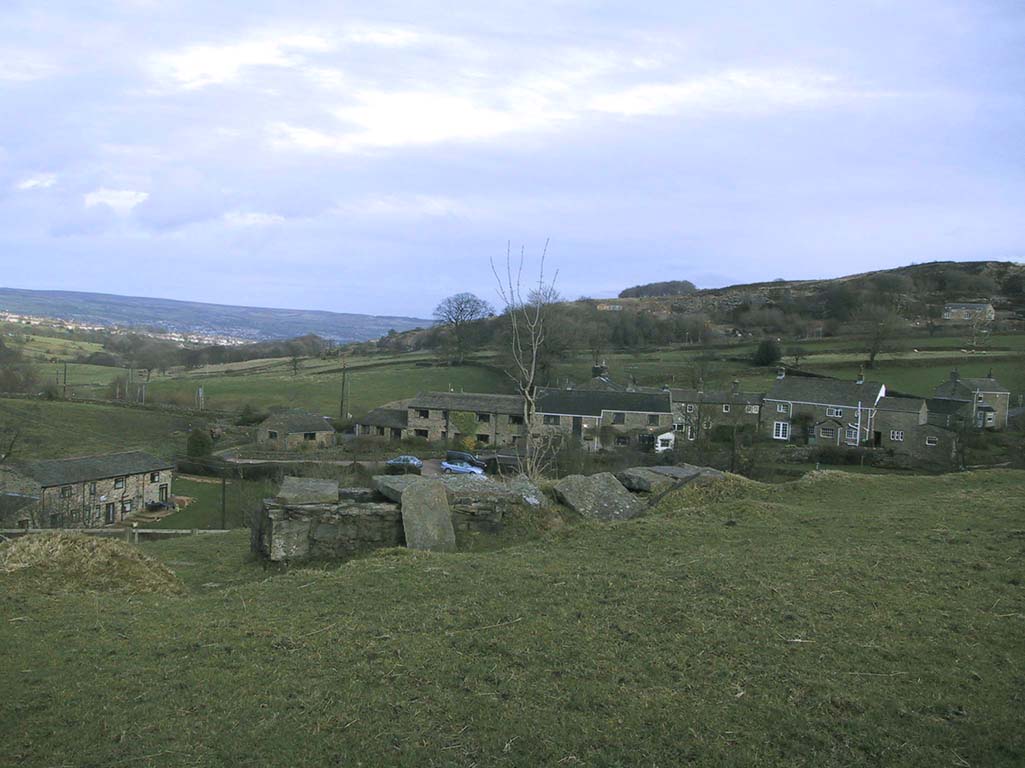Healing Well: OS Grid Reference – SE 0272 4017

Take the Oakworth Road outta Keighley, turning right after a quarter-mile up Fell Lane. Go all the way up the very end (a mile or so), turning right at the end. After 100 yards or so, go up the track to the True Well Hall equestrian centre. As you approach the farmhouse, look on the grassy slope to the left and you’ll see a small run-down stone structure in the field above you. That’s it!
Archaeology & History
This is a curious site by virtue of so little being said of it, despite some modern proclamations of it having pagan values. Even the local historians say little on the place, with William Keighley (1858) being our notable exception. In his notes on the erroneous dedication of the Jennet’s Well to a fictitious saint of the same name, he mentions this once important water supply, writing:
“Westwards of Jennet’s Well there was another fountain, emphatically styled the ‘true well’, and probably from its once boasted efficacy intended as a rival to the former. This spring though no longer remembered for its healing qualities, evidently gave name to the farmhouse denominated ‘True Well Hole.'”
In Wright’s Dialect Dictionary (1898) we find the word ‘trew’ — also written as ‘true’ or ‘trow’ — could mean “to trust, believe, feel sure”, which may be applicable in terms of the value of the waters that once flowed here. We may never know. Though note should be made of the error at a recent exhibition in Cliffe Castle museum, where the 1842 Tithe Awards map of the region was copied and the field-names listed, showing the old True Well erroneously displayed as the ‘Time Well’. I assume they must have had a long day when they were copying the notes…!

A little further along the track running beyond True Well Farm we find another spring of water emerging from the grassy hill and which, perhaps, relates to the True Well. On the 1852 OS-map, we see a ‘trough’ shown in front of the farmhouse and not in the position where the modern map shows the True Well to be — and where the recent stone-worked trough in the photo is shown. In fact, on the 1852 map, no such well nor stonework is shown in the position presently deemed to be where the True Well is supposed to be, so the original position of the well is unclear. Is it possible that the spring of water which runs from the hillside behind True Well Farm may have been the site which gave this spot its name. Certainly the water from this spring is quite fresh and drinkable. If anyone knows owt more about the history of this curious site, it would be good to hear from you.
References:
- Keighley, William, Keighley Past and Present, Arthur Hall: London 1858.
© Paul Bennett, The Northern Antiquarian
The map could not be loaded. Please contact the site owner.
In all kinds of ways ‘Jenny’, ‘Jennet’ or ‘Jinny’ is attached to objects and concepts that have to do with magical, supernatural and pagan divine. ‘Jinny greenteeth’, locally associated with the Newchurch Jinny Well, is the unprepossessing name for an unfriendly spirit haunting wells and ponds, and also for the lesser duckweed growing on the water’s surface.
Jinny Greenteeth, or the Greentoothed Woman, most probably originated in Central Europe among the many myths and legends of the Slavic peoples. The spirit of lakes and ponds, the rusalka or water nymph, charmed passers-by with her song so that some would drown themselves for her sake, a terrestrial mermaid of sorts. She had kin in Baba Yaga (Ye-gar), crone and archetype, a witch who took delight in eating children and many stories of evil creatures that drowned their victims can be reminiscent of the tales of Jinny Greenteeth.
Some believe that Jinny was merely an alias for lesser duckweed (‘witches manna’) that could wrap itself around the leg of an individual and trap them under water, a danger to small children if they caught themselves in it. Others explained her away as an allegory that would ensure children and the foolhardy kept away from the edges of pools, ponds, rivers and lakes, otherwise she would come up and drag them in and eat them. Whatever the case, Jinny will always be there under the surface of the water, waiting for her next meal.
http://www.aussteigerpublications.com